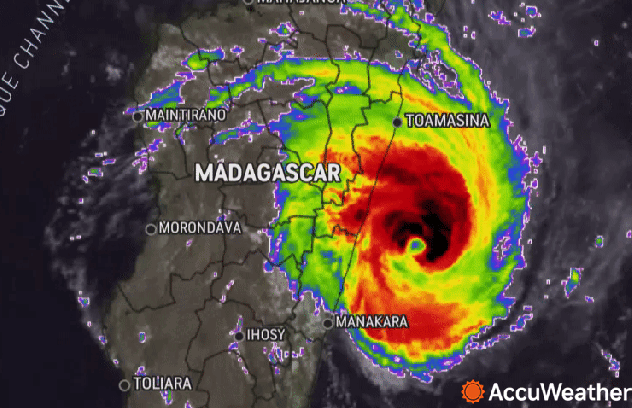Four people were killed when Tropical Cyclone Freddy, which had resurfaced, slammed Madagascar on Monday.
Four people were killed when Tropical Cyclone Freddy, which had resurfaced, slammed Madagascar on Monday.

A resurgent Tropical Cyclone Freddy struck Madagascar again Monday with heavy rain and strong winds, leaving four people dead nearly two weeks after the storm’s initial destructive passage through the island nation.
Freddy, which has become one of the longest-tracked tropical systems of all time, took an unusual path across the Indian Ocean before initially slamming into Madagascar on Feb. 21 and making its way into Mozambique. According to AFP, the storm’s total death toll in Madagascar now stands at 11. The four latest victims from the storm were a 1-year-old, who died when a house collapsed, a 2-year-old child and two women in their 50s. Specific details were not available for the deaths of the two women or the 2-year-old child, AFP reported.
Severe tropical storm Freddy has been a presence in the Indian Ocean for a month, traveling more than 4,000 miles from near Indonesia on Feb. 6 before eventually wreaking havoc in Madagascar and Mozambique.

Freddy continues to maintain its rotation as it once again heads toward Mozambique, where it will make its third overall landfall and second in the country. No other tropical cyclones observed in the past two decades in this part of the world have taken the unique path across the Indian Ocean that Freddy has. In 2000, Cyclone Leon, also known as Eline, followed a similar track that covered nearly 7,000 miles over 29 days.
Freddy was upgraded to a tropical cyclone on Feb. 7, then quickly upgraded to an Intense tropical cyclone by forecasters later on Feb. 7, with maximum sustained winds of 105 mph (169 km (554489.00 feet)/h) – equivalent to a Category 2 hurricane.
Freddy remained over the Indian Ocean for nearly two weeks, peaking as a very intense tropical cyclone with 155 mph (249 km (816969.00 feet)/h) maximum sustained winds on Feb. 15 and then again on Feb. 19. A maximum sustained wind of 155 mph is equal to a high-end Category 4 hurricane.
On Feb. 20, Freddy closely approached the islands of Mauritius and Reunion. Winds at Signal Mountain on Mauritius reached 95 mph (154 km (505274.00 feet)/h). The island encountered flooding from the storm, according to The Associated Press. On Reunion, about 25,000 customers lost power and a landslide closed the RD48 road in Salazie.

The next day, Freddy made its first official landfall when its eye moved ashore near Mananjary, Madagascar. By Feb. 21, Freddy had lost some strength as its maximum sustained winds declined to 80 mph (129 km (423249.00 feet)/h). However, the impacts on Madagascar were immense.

Strong wind gusts flattened rice fields and fruit trees and tore roofs off buildings, AFP reported. More than 6,700 homes were damaged. The city of Mananjary, home to around 25,000 people and near where Freddy moved ashore, received nearly 5 inches of rain, with sustained winds of 92 mph at landfall. At least 16,000 people had been displaced around Mananjary.
After moving offshore of Madagascar, the deadly cyclone took aim at Mozambique, where it made its second landfall just south of Vilankulos, Mozambique, on Feb. 24, resulting in significant damage to infrastructure. At least seven were killed in Mozambique from Freddy, according to AFP.
The tropical storm brought heavy rain and between 10-12 inches of precipitation over three days. Freddy affected over 163,000 people and 34,000 families, according to OCHA. About 15,000 homes were totally or partially destroyed and nearly 20,000 homes were flooded, the National Institute for Disaster Risk Management estimated.

The tropical storm rapidly lost wind intensity and became an overland depression as it continued into southeastern Africa on Feb. 24. The Joint Typhoon Warning Center discontinued warnings on Freddy later on Feb. 24 as it continued to lose strength.

About a week later, what was left of Freddy began to move over the Mozambique Channel, giving the system rejuvenated energy and allowing it to strengthen back into a tropical cyclone. Freddy was officially reclassified as a moderate tropical storm on March 4, with maximum sustained winds of 45 mph (72 km (236232.00 feet)/h). Freddy then moved eastward toward Madagascar, impacting the island once again with strong winds and rain.
As of 10:04 p.m. Réunion Time on March 6, Freddy was classified as a severe tropical storm by Meteo France, with maximum sustained winds of 60 mph (97 km (318257.00 feet)/h) and heading west toward Mozambique, where it is forecast to make a third landfall.
AccuWeather meteorologists say Freddy will bring additional heavy rain as well as strong winds to parts of western and southern Madagascar into Tuesday, and then it can strike northern Mozambique as a tropical cyclone late this week.
Produced in association with AccuWeather

